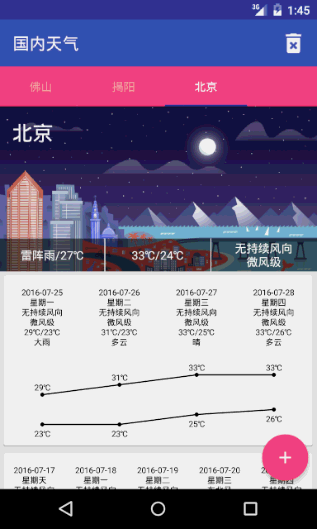之前写了个天气APP,带4天预报和5天历史信息。所以想着要不要加一个折线图来显示一下天气变化趋势,难得有空,就写了一下,这里做些记录,脑袋不好使容易忘事。
先放一下效果:

控件内容比较简单,就是一个普通的折线图,上下分别带有数字,点击的时候显示当天温度的差值。
创建一个类继承自View,并添加两个构造方法:
public class TrendGraph extends View { public TrendGraph(Context context) { // 在java代码中创建调用 super(context); } public TrendGraph(Context context, AttributeSet attrs) { // 在xml中创建调用 super(context, attrs); } }
因为这里不需要考虑wrap_content的情况,所以onMeasure方法不需重写,关键的是onDraw,而onDraw方法其实也不困难,只需要确定好每个点的具体位置就好,因为连线也是需要点的坐标,代码比较啰嗦,可以略过:
1 @Override 2 protected void onDraw(Canvas canvas) { 3 super.onDraw(canvas); 4 if (mElements == null || mElements.size() == 0) { 5 return; 6 } 7 double max_up = getMaxUp(); 8 double min_down = getMinDown(); 9 canvas.setDrawFilter(mDrawFilter); 10 mPaint.setStrokeWidth(lineWeith); 11 float width = getWidth(); 12 float grap = width / mElements.size(); 13 float textSize = mTextPaint.getTextSize(); 14 int textMargin = circleRadius * 2; 15 float margin_top = textSize + 2 * textMargin; 16 Log.d(TAG, "onDraw: " + margin_top + "|" + textSize); 17 float height = getHeight() - 2 * margin_top; 18 19 for (int i = 0; i < mElements.size() - 1; i++) { 20 float startX = i * grap + grap / 2; 21 float stopX = (i + 1) * grap + grap / 2; 22 float startY = (float) (max_up - mElements.get(i).getUp()) / (float) (max_up - 23 min_down) * height + margin_top; 24 float stopY = (float) (max_up - mElements.get(i + 1).getUp()) / (float) (max_up - 25 min_down) * height + margin_top; 26 27 canvas.drawText((int) mElements.get(i).getUp() + "℃", startX - textSize, startY - 28 textMargin, mTextPaint); 29 canvas.drawCircle(startX, startY, circleRadius, mPaint); 30 canvas.drawLine(startX, startY, stopX, stopY, mPaint); 31 if (i == mElements.size() - 2) { 32 canvas.drawText((int) mElements.get(i + 1).getUp() + "℃", stopX - textSize, stopY 33 - textMargin, mTextPaint); 34 canvas.drawCircle(stopX, stopY, circleRadius, mPaint); 35 } 36 37 startY = (float) (max_up - mElements.get(i).getDown()) / (float) (max_up - min_down) * 38 height + margin_top; 39 stopY = (float) (max_up - mElements.get(i + 1).getDown()) / (float) (max_up - 40 min_down) * height + margin_top; 41 canvas.drawText((int) mElements.get(i).getDown() + "℃", startX - textSize, startY + 42 textSize + textMargin, mTextPaint); 43 canvas.drawCircle(startX, startY, circleRadius, mPaint); 44 canvas.drawLine(startX, startY, stopX, stopY, mPaint); 45 if (i == mElements.size() - 2) { 46 canvas.drawText((int) mElements.get(i + 1).getDown() + "℃", stopX - textSize, 47 stopY + textSize + textMargin, mTextPaint); 48 canvas.drawCircle(stopX, stopY, circleRadius, mPaint); 49 } 50 } 51 }
考虑到需要允许用户进行简单的设置,例如点的大小,文字大小等等,所以定义一些自定义属性(res/values/attr.xml):
<?xml version="1.0" encoding="utf-8"?> <resources> <declare-styleable name="TrendGraph"> <attr name="lineWidth" format="dimension"/> <attr name="circleRadius" format="dimension" /> <attr name="textSize" format="dimension" /> <attr name="textColor" format="reference" /> </declare-styleable> </resources>
format指该属性的格式,指定为dimension则是尺寸,取值单位是dp、sp或px等等,而reference则是引用,即一般在xml中引用其他资源的写法,如@string/app_name。还有其他类型,可以自行查找文档。
对自定义属性进行解析得到,这个解析需要在上面定义的第二个构造方法中进行,代码如下:
public TrendGraph(Context context, AttributeSet attrs) { super(context, attrs); TypedArray array = getContext().obtainStyledAttributes(attrs, R.styleable.TrendGraph); circleRadius = array.getDimensionPixelSize(R.styleable.TrendGraph_circleRadius, 5); lineWeith = array.getDimensionPixelSize(R.styleable.TrendGraph_lineWidth, 3); mTextPaint.setTextSize(array.getDimensionPixelSize(R.styleable.TrendGraph_textSize, 35)); mTextPaint.setColor(array.getColor(R.styleable.TrendGraph_textColor, Color.BLACK)); array.recycle(); }
getDimensionPixelSize方法则是通过传入的值,转换为具体的像素(px)值,也就免去我们手动转换的麻烦。但是要注意,其中的defaultValue依然是px。
接着,就可以通过xml指定这些属性,在布局中加入命名空间:
xmlns:app="http://schemas.android.com/apk/res-auto"
则Android Studio会自动引入,并且可以补全得到,具体使用:
<com.fndroid.byweather.views.TrendGraph android:id="@+id/tg" android:layout_width="match_parent" app:textColor="@color/colorAccent" app:textSize="22sp" app:circleRadius="2dp" android:layout_height="200dp"/>
最后,添加一个事件监听,在点击View的时候进行回调:
① 定义接口:
public interface onItemClickListener{ void onItemClick(View view, Element element); }
② 在View中添加接口对象,并设置setter方法:
public class TrendGraph extends View { private onItemClickListener mOnItemClickListener; // 省略代码 public void setOnItemClickListener(onItemClickListener onItemClickListener) { mOnItemClickListener = onItemClickListener; } }
③ 处理onTouchEvent,重写该方法,代码如下:
@Override public boolean onTouchEvent(MotionEvent event) { int viewWidth = getWidth(); int itemWidth = viewWidth / mElements.size(); int viewHeight = getHeight(); boolean isMove = false; // 界面中最外层为一个NestedScrollView,所以为了避免滑动时也触发,加入变量处理 switch (event.getAction()) { case MotionEvent.ACTION_MOVE: isMove = true; break; case MotionEvent.ACTION_UP: if (!isMove){ // 判断只有点击时进行回调 int position = (int) (event.getX() / itemWidth); // 取得点击的位置 mOnItemClickListener.onItemClick(this, mElements.get(position)); // 回调 } break; } return true; }
④ 在Activity中,进行监听设置,并处理:
historyGraph.setOnItemClickListener(this);
@Override public void onItemClick(View view, TrendGraph.Element element) { int dt = (int) (element.getUp() - element.getDown()); Snackbar.make(root, "当天温差为:" + dt + "℃", Snackbar.LENGTH_SHORT).show(); }
效果完成!欢迎大家关注交流。